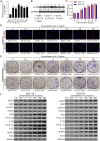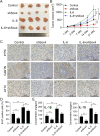Interleukin-6 mediated inflammasome activation promotes oral squamous cell carcinoma progression via JAK2/STAT3/Sox4/NLRP3 signaling pathway
- PMID: 35513871
- PMCID: PMC9069786
- DOI: 10.1186/s13046-022-02376-4
Interleukin-6 mediated inflammasome activation promotes oral squamous cell carcinoma progression via JAK2/STAT3/Sox4/NLRP3 signaling pathway
Abstract
Background: Interleukin-6 (IL-6) has been reported to be critical in oral squamous cell carcinoma (OSCC). However, the set of pathways that IL-6 might activate in OSCC are not fully understood.
Methods: IL-6 and Sox4 expressions were first determined with RT-qPCR, ELISA, Western blot, or immunohistochemistry in OSCC tissues, and correlations between IL-6 and Sox4 expression and patient pathological characteristics were examined, and Kaplan-Meier approach was employed for evaluating the prognostic utility in OSCC patients. CCK-8, EdU stain and colony formation assays were utilized to test cell proliferation in vitro. Mechanistically, downstream regulatory proteins of IL-6 were verified through chromatin immunoprecipitation, luciferase reporter, pull-down, and the rescued experiments. Western blot was used for detecting protein expression. A nude mouse tumorigenicity assay was used to confirm the role of IL-6 and Sox4 in vivo.
Results: IL-6 was upregulated in OSCC tissues, and Sox4 expression was positively correlated with IL-6 expression. High IL-6 and Sox4 expression was closely related to tumor size, TNM stage, and a poorer overall survival. Besides, IL-6 could accelerate OSCC cell proliferation by activating inflammasome via JAK2/STAT3/Sox4/NLRP3 pathways in vitro and in vivo. Furthermore, STAT3 played as a transcription factor which positively regulated Sox4, and IL-6 promotes Sox4 expression by activating JAK2/STAT3 pathway. Moreover, through the rescue experiments, we further confirmed that IL-6 could promote proliferation and NLRP3 inflammasome activation via JAK2/STAT3/Sox4 pathway in OSCC cells. Finally, knockdown of Sox4 suppressed OSCC growth in vivo, and antagonized the acceleration of IL-6 on tumor growth.
Conclusions: We confirmed that IL-6 plays an oncogenic role in OSCC progression by activating JAK2/STAT3/Sox4/NLRP3 pathway, which might be the therapeutic targets for OSCC remedy.
Keywords: IL-6; JAK2; NLRP3 inflammasome; NLRP3 pathway; Oral squamous cell carcinoma; STAT3; Sox4.
© 2022. The Author(s).
Conflict of interest statement
The authors declare that they have no competing interests.
Figures











Similar articles
-
SOAT1 Activates NLRP3 Inflammasome to Promote Cancer-Related Lymphangiogenesis and Metastasis via IL-1β/IL-1R-1 Axis in Oral Squamous Cell Carcinoma.Mol Carcinog. 2025 Jun;64(6):1039-1056. doi: 10.1002/mc.23907. Epub 2025 Mar 26. Mol Carcinog. 2025. PMID: 40135589 Free PMC article.
-
The role of NLRP3 inflammasome in 5-fluorouracil resistance of oral squamous cell carcinoma.J Exp Clin Cancer Res. 2017 Jun 21;36(1):81. doi: 10.1186/s13046-017-0553-x. J Exp Clin Cancer Res. 2017. PMID: 28637493 Free PMC article. Clinical Trial.
-
Janus Kinase Inhibition Ameliorates Ischemic Stroke Injury and Neuroinflammation Through Reducing NLRP3 Inflammasome Activation via JAK2/STAT3 Pathway Inhibition.Front Immunol. 2021 Jul 22;12:714943. doi: 10.3389/fimmu.2021.714943. eCollection 2021. Front Immunol. 2021. PMID: 34367186 Free PMC article.
-
STAT3 and Its Targeting Inhibitors in Oral Squamous Cell Carcinoma.Cells. 2022 Oct 5;11(19):3131. doi: 10.3390/cells11193131. Cells. 2022. PMID: 36231093 Free PMC article. Review.
-
The Role of IL-17 in the Pathogenesis of Oral Squamous Cell Carcinoma.Int J Mol Sci. 2023 Jun 8;24(12):9874. doi: 10.3390/ijms24129874. Int J Mol Sci. 2023. PMID: 37373022 Free PMC article. Review.
Cited by
-
Anlotinib inhibits cervical cancer cell proliferation and invasion by suppressing cytokine secretion in activated cancer-associated fibroblasts.Front Oncol. 2024 Aug 13;14:1412660. doi: 10.3389/fonc.2024.1412660. eCollection 2024. Front Oncol. 2024. PMID: 39193386 Free PMC article.
-
Inhibition of NLRP3 inflammasome activation by caffeine might be a potential mechanism to reduce the risk of squamous cell carcinoma of the oral cavity and oropharynx with coffee drinking.Front Oral Health. 2022 Sep 22;3:1017543. doi: 10.3389/froh.2022.1017543. eCollection 2022. Front Oral Health. 2022. PMID: 36325196 Free PMC article. No abstract available.
-
CRISPR/Cas9-mediated Knockout of LYVE1 In Human Tongue Cancer Cells Reveals Transcriptomic Changes in Metastasis-associated Pathways.Cancer Genomics Proteomics. 2025 Jun 26;22(4):525-537. doi: 10.21873/cgp.20519. Cancer Genomics Proteomics. 2025. PMID: 40571317 Free PMC article.
-
Chemerin promotes invasion of oral squamous cell carcinoma by stimulating IL-6 and TNF-α production via STAT3 activation.Mol Biol Rep. 2024 Mar 23;51(1):436. doi: 10.1007/s11033-024-09359-y. Mol Biol Rep. 2024. PMID: 38520551
-
Integrative Network Pharmacology and Molecular Docking Analyses on the Mechanisms of San-Zhong-Kui-Jian-Tang in Treating Oral Squamous Cell Carcinoma.Curr Med Sci. 2025 Aug;45(4):755-774. doi: 10.1007/s11596-025-00067-7. Epub 2025 Jun 17. Curr Med Sci. 2025. PMID: 40526272
References
-
- Wang Y, Hu H, Wang Q, Li Z, Zhu Y, Zhang W, et al. The level and clinical significance of 5-hydroxymethylcytosine in oral squamous cell carcinoma: An immunohistochemical study in 95 patients. Pathol Res Pract. 2017;213(8):969–974. - PubMed
-
- Panarese I, Aquino G, Ronchi A, Longo F, Montella M, Cozzolino I, et al. Oral and Oropharyngeal squamous cell carcinoma: prognostic and predictive parameters in the etiopathogenetic route. Expert Rev Anticancer Ther. 2019;19(2):105–119. - PubMed
MeSH terms
Substances
Grants and funding
LinkOut - more resources
Full Text Sources
Medical
Miscellaneous

